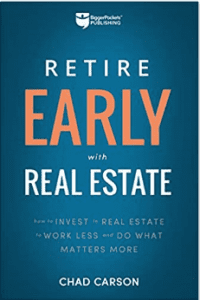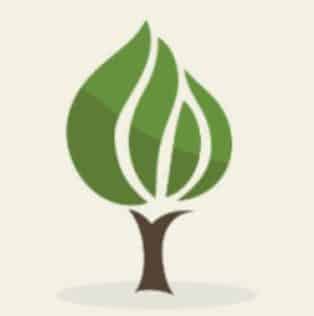A few weeks ago I published an update of our 2018 goals, with one goal to read at least 20 books this year. I’ve attempted to be more adventurous with my book selections and branch out to read more fiction and other non-personal finance related books. Some books I’ve read in a couple days, while others took me a month plus. Some I didn’t finish at all. It was nice to go back to reading a personal finance related book. Chad Carson’s new book, Retire Early with Real Estate, was one of those books that I devoured in a few days.
I have long been a fan of the BiggerPockets forum and podcasts and last year I upgraded to a Pro account. When I came across a post from Chad to review his new book Retire Early with Real Estate, I jumped at the chance. The book did not disappoint.
Perfect Timing
We have long been interested in investing in real estate. In fact, we dipped our toes in the real estate pool a couple times. The first time was back in 2013 when we became silent partners in a two-house deal. In the end, we made a little money (less than $1,000) although it tied up our money for too long. It wasn’t a terrible deal but was also far from a great investment.
A few years later we had a house under contract but backed out after the inspection. The house was a good deal, but we weren’t ready at the time. We were planning to use home equity from our personal residence to purchase the property. There were too many uncertainties in the inspection for our first deal. Maybe we just got scared, though my gut tells me it was the right move because a deal gone wrong could have impacted our personal residence. You can read more about this story here: Backing Out of a $70,000 Profit House Flip
After that experience we decided to go all in to pay off our mortgage. We achieved the goal at the beginning of August 2018. We’re now ready to take another shot at real estate. The 1 percent rule is still realistic.
The 1 percent rule is a general rule of thumb used by real estate investors to evaluate a deal. This rule says that the expected monthly rent of a property should be greater than 1 percent of the purchase price. (e.g., a home purchased for $100,000 should rent for $1,000 or more.)
The opportunity to read this book came up at the perfect time. We have been thinking a lot about our approach when we get into real estate. Do we want to save up money and purchase our first property with cash or put down 20 percent and leverage? If we move out of our personal residence, what is our next move? This book answered all of these questions and more.

My Review of Retire Early with Real Estate
If you are someone looking to break into the real estate game, this is the perfect book for you. The book is broken up into seven parts, each building on the previous part. I’d argue that each part and maybe even each chapter could be its own book. The beauty of this book is that it runs through a number of different strategies to retire early with real estate so that you can choose the strategy that works best for you. The book is easy to read, and the well-placed visuals in almost every chapter help make connections for visual learners such as myself.
My favorite part of the book is the end-of-chapter profiles of individuals who have retired early, many using real estate as their primary vehicle. It gave me the opportunity to learn the background of several individuals in the personal finance community that I have come to know by reading blogs, listening to podcasts, and interacting with on social media (and hopefully will get to meet at FinCon).
Below is a high-level breakdown of each section in the book.
Part 1: Why Real Estate Investing?
In this section, Coach Carson makes the case for Real Estate Investing. You’ll learn about the acronym IDEAL and discover some of the benefits that real estate offers over stocks. For example, there are additional tax benefits such as depreciation that you can capitalize on in real estate, which isn’t an option with stocks and other investments.
Part 2: A Map of the Financial Mountain
This section hits on several key points that aren’t discussed in many other personal finance books. For example, many people on their journey to financial independence seem to think that once they achieve their goal all of their problems will go away. I truly believe that achieving financial independence can improve quality of life. Why else would we be pursuing it if not? However, if you are a miserable person today then achieving financial independence isn’t going to automatically make you happy.
We should all be working to make ourselves better people right now. Just because you’re in debt doesn’t mean that you can’t invest in quality relationships, make healthy food choices, exercise, learn mindfulness, and on and on. The part of the book that really got me thinking was the “enough” number. People can spend their whole lives chasing money and never be happy. However, if you know how much money you need to live a comfortable life, that is usually “enough”. After that, your happiness will be defined by non-money factors such as your relationships, hobbies, and other interests.
Part 3: Preparations for the Climb
There are several real estate books and courses out there that teach you how to make money in real estate without having money. This is certainly possible, though having a strong financial foundation will greatly increase your chances of success. The theme of this section is to get your financial life in at least decent shape before considering investing in real estate. If you are already buried in debt with little money in the bank, investing in real estate could be the powder keg that blows up your financial situation.
I’ve mentioned several times in this blog that personal finance on the surface is simple. Spend less than you earn and invest the difference in assets. It’s so simple, yet can be so difficult. This section provides ideas to control your expenses, increase your income, and evaluate the wealthy stage you are in.
Part 4: The First Steps
This is where the book got really good for me. In this part, Chad covers several real estate wealth building plans such as house hacking, the live-in flip, and the buy, rehab, rent, refinance, repeat (BRRRR) strategy. If I had to do it all over again and had my financial life and plan in order in my early-to-mid 20s, I would absolutely start with house hacking.
After graduating from college, I lived in a duplex with three other guys. We all diligently paid our rent to the landlord every month. Even though I didn’t have much money back then, with a FHA loan it would have been possible to buy that duplex for about $5,000 down. Instead of those rent checks going to the landlord, they could have gone straight to me, which would have allowed me to live for free or close to it.
The other wealth building plans provide a few great ideas for what we may be able to accomplish after getting a later start on our personal finance journey.
Part 5: The Climb
This section includes the primary vehicles that investors use to build wealth through real estate. This includes three plans: “The Rental Debt Snowball Plan”, “The Buy and Hold Plan”, and “The Trade-up Plan”.
The chapter on the rental debt snowball was my favorite chapter in the book. It opened my eyes on how to invest in real estate and eventually become debt free. While we eventually want to own rental property free and clear, saving up the money to buy a property outright would take a really long time. I really like the idea of buying three or four properties with leverage, then taking a break from buying to pay down each home before potentially purchasing additional properties.
Part 6: The Peak and Beyond
Not everyone will make it to this stage of the game. For those able to make it to the peak, this section provides examples on how to maintain your wealth even if you decide to retire early.
The chapter that I found most interesting was on how to leverage retirement accounts to invest in real estate. The majority of our net worth is tied up in pre-tax retirement accounts. We’ve been more interested recently in exploring opportunities for early withdrawal. Paying a 10 percent penalty and a heavy tax bill doesn’t sound appealing, but there are a few options that can make an early withdrawal possible. I made a list of a few options that I plan to research further.
What I also liked about this section was the focus on other aspects of life besides money. Health, relationships, and mindset must be an area of focus along with our finances. Becoming financially independent isn’t going to magically make anyone happy, though it can significantly improve the life of a family who already has a strong foundation.
It’s also important to have an idea of how much money is enough. There are certainly diminishing marginal returns the more money you have, so chasing a number once you are financially secure may not be wise.
Part 7: Your Turn to Climb
This section provides a high level overview of how to get started in your early retirement journey. It ties together all the previous sections and provides a roadmap of what you’ll want to consider on your journey.

How Can We Apply this Book to Our Journey?
As a wrap up, I asked Chad what he would do if his family was in a similar situation to ours. My wife and I are in our mid-30s with two young children, recently became completely debt free, fund our retirement accounts, and make a low six figure salary. See below for his response:
“Getting started with real estate investing can be intimidating. It’s a big purchase, after all! But for someone in your situation, I do have a recommendation that could make this transition easier.
If at all possible I recommend turning your home into an investment using strategies like the Live-In-Then-Rent or House Hack. I’ll explain what those are in just a second. And I know – this may not be what you wanted to hear! After all, your home is where the heart is. It’s your haven. It’s a place to raise a family. But hear me out why this can be so beneficial.
One way to turn your home into an investment is something I call the “Live-In-Then-Rent.” So, if you’re living in a reasonable home (i.e. not a huge luxury house), it’s possible you could rent the home out and go buy another one to live in.
The first step is to run the numbers. What would your house rent for? How much would your NET rental income be (after all expenses, including maintenance and potentially hiring a manager)?
See related article: We Paid Off the Mortgage: Our Debt Free Journey
And beyond the numbers, is this a good house to rent? My ideal rental homes have simple floor plans (i.e. rectangles!!), simple roof lines, manageable yards, and low-maintenance materials (exterior and interior). If your house is a high-maintenance nightmare, it might not make the ideal rental.
If all of that looks good, you’ll obviously have to figure out how to buy the next house. You’ve done a great job paying your home off, so you may not be excited about going into debt again. It’s certainly a personal choice.
But I have always been ok with intelligent risk-taking, as in owning an investment that conservatively covers all of my expenses, including a mortgage. If you can save enough for another down payment, you’ll have the rent from your old home to help you pay for the new mortgage. And you can use a rental debt snowball to quickly attack your new mortgage and pay it off MUCH faster than you did before.
In the end, you’ll have TWO paid off homes. Then if you want, you can do it again. Or if that’s enough, you can move on to other investments or projects in your life.
Finally, you can make this entire arrangement even sweeter by purchasing a new house that also has extra rental potential. So, if you could buy a duplex or a house with a rental apartment in the garage or basement, you could do what’s called a “house hack.” This just means you generate income from the home you’re living in. This income could be from a long-term renter, or you could do a short-term Airbnb rental (check your local laws to make sure that’s possible). And because you have even more extra income, you’ll accelerate your debt snowball EVEN faster.
That’s just one approach to getting started. Obviously, you could just buy a straight rental property instead of turning your home into a residence. Whatever you choose, I wish you the best of luck. I hope you’ll reach out and let me know how you progress!!”
These are great ideas! The home we’re currently in most likely isn’t our forever home. It also checks many of the boxes to potentially become a great rental. We would need to follow up with our CPA to ensure this strategy would work best for our situation. For example, if we moved out of our current home and sold the home years down the road, would we have to pay taxes on the gains compared to the purchase price? If we sold today we’d get a decent amount more than what we paid for. I also like the idea of keeping this home in our family as it has some sentimental value to us.
Retire Early with Real Estate
If you are in a situation where you may want to use real estate to retire early or become financially independent, you need to read this book. It will allow you to develop a plan of action to achieve your goals. I am walking away with a few areas to dig deeper into. Thanks to Chad Carson for allowing me to review his book and write about it!
You can purchase the book here.

Mark is the founder of Financial Pilgrimage, a blog dedicated to helping young families pay down debt and live financially free. Mark has a Bachelor’s degree in financial management and a Master’s degree in economics and finance. He is a husband of one and father of two and calls St. Louis, MO, home. He also loves playing in old man baseball leagues, working out, and being anywhere near the water. Mark has been featured in Yahoo! Finance, NerdWallet, and the Plutus Awards Showcase.


Fantastic blog you have here but I was curious about if you knew of any
forums that cover the same topics discussed in this article?
I’d really love to be a part of group where I can get suggestions from other knowledgeable individuals that share the same interest.
If you have any recommendations, please let me know. Thanks!
Are you on Facebook by chance? There are a few groups that I’m apart of that have great discussion.
ChooseFI
Slow FI Enthusiasts
The Millennial Money Man Community
Thriving Families